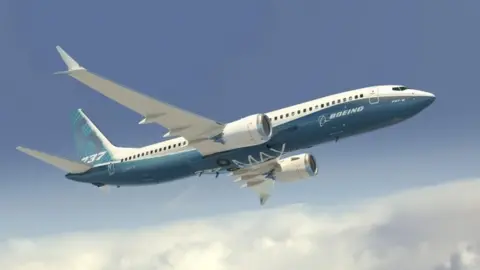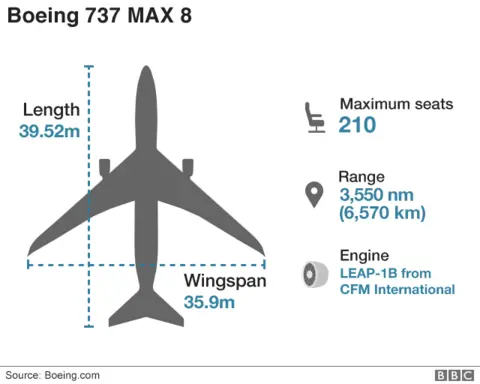Lion Air: How could a brand new plane crash?
 Boeing
BoeingLion Air flight JT 610 has crashed into the sea, with nearly 190 people on board, shortly after taking off from the Indonesian capital, Jakarta.
A lot of attention has focused on the fact the plane, a Boeing 737 MAX 8, was brand new. This is the first major incident involving that kind of plane.
Details so far have been scant and the cause will not be confirmed until a full investigation has been carried out.
Plane crashes are often the result of a combination of factors - both technical and human - but could the fact that the plane was so new have played any part?
The Boeing 737 MAX 8 has only been in commercial use since 2017.
Budget carrier Lion Air said in July it was "very proud" to be the first in Indonesia to deploy the plane, and that it had ordered as many as 218 units.
The plane involved in Monday's incident has only been in operation since 15 August.

It had logged only 800 hours of flight time, according to the head of the National Transportation Safety Commission, Soerjanto Tjahjano.
The pilot is reported to have radioed air traffic control in Jakarta asking for permission to turn back, shortly after taking off.
Now it has emerged that the plane had some technical problems on Sunday on its penultimate flight.
A technical log obtained by the BBC for that flight - from Denpasar airport in Bali to Jakarta - suggests that the airspeed reading on the captain's instrument was unreliable, and the altitude readings differed on the captain's and first officer's instruments.
As a result of the problem, the captain handed over control of the plane to the first officer, the crew continued their flight and they landed safely at Jakarta.
Lion Air have not confirmed the report, but this may have been the unspecified "technical problem" that the company's chief executive said the plane's Denpasar to Jakarta flight had suffered from.
Edward Sirait said that this problem had been "resolved according to procedure".
He added that Lion Air was currently operating 11 aircraft of the same model. He said there were no plans to ground the rest of the planes.
'Snags' sorted quickly
Aviation analyst Gerry Soejatman told the BBC that usually it is old aircraft that are at the highest risk of accidents but that there can also be problems with very new ones.
"If it's very new there are sometimes snags that only reveal themselves after they are [used routinely]," he said. "These usually get sorted [within] the first three months."


The plane would have hit the three-month mark in just a few weeks.
Another analyst, Jon Ostrower of aviation publication The Air Current, said there were "always new teething issues... that's common, but a far cry from something that would threaten the safety of an aeroplane".
He added that new planes generally "enjoy a maintenance holiday because everything is so new, not the reverse".
Both analysts said it was too early to draw definitive conclusions about what had gone wrong with Flight JT 610.
"I don't know what would make a plane this new crash," Mr Ostrower told the BBC. "There are so many different factors that can contribute to an accident like this."
Mr Soejatman said he believed it was "likely to be technical issues that caused it but it's still very early days".
"We can really [only determine the cause] when we get more information," he said.
Indonesia's poor aviation safety record, though, has other experts believing that factors such as human error or poor oversight are more likely to be behind Monday's tragedy.
Boeing has said it is "deeply saddened" by the loss of the plane. It sent its sympathies to the victims' families and said it would co-operate with the investigation.
According to Boeing, the 737 MAX series is the fastest-selling plane in its history, and has accumulated almost 4,700 orders.
The MAX 8 has been ordered by airlines including American Airlines, United Airlines, Norwegian and FlyDubai.
